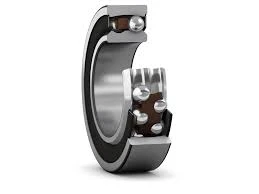
ഡിസം . 04, 2024 06:38 Back to list
spherical roller bearing vs ball bearing
Spherical Roller Bearing vs. Ball Bearing A Comparative Analysis
In the world of mechanical engineering and manufacturing, bearings play a crucial role in reducing friction between moving parts and ensuring the smooth operation of machinery. Among the various types of bearings, spherical roller bearings and ball bearings are two of the most commonly used. Each type has its unique advantages and applications, making the choice between them dependent on specific operational requirements.
Structure and Design
The primary difference between spherical roller bearings and ball bearings lies in their structure. Spherical roller bearings have two rows of symmetrical rolling elements (rollers) that can accommodate misalignment and angular displacement. They are typically designed with a large contact area, allowing them to support heavy radial and axial loads. The inner ring of a spherical roller bearing has a spherical raceway, enabling it to self-align when subjected to misalignments.
On the other hand, ball bearings consist of a series of balls that sit between inner and outer races. The design of ball bearings allows for lower friction, making them suitable for high-speed applications. However, their capacity to handle misalignment is limited compared to spherical roller bearings.
Load Capacities
When it comes to load-bearing capabilities, spherical roller bearings excel in heavy load situations. They can support both radial and axial loads simultaneously, which makes them ideal for applications involving heavy machinery, such as mining equipment and construction vehicles. The ability to handle load applications in multiple directions further enhances their utility in demanding environments.
Ball bearings, although effective in moderate load applications, are generally not suited for very high load scenarios. They are commonly found in electric motors, automotive applications, and various consumer goods, where the load requirements are less extreme.
Speed and Friction
One of the notable benefits of ball bearings is their low friction coefficient, which translates into higher operational speeds. This feature is particularly advantageous in applications requiring quick, efficient movement, such as in fans or high-speed machinery. The smooth rolling motion of the balls minimizes energy loss, contributing to better efficiency.
spherical roller bearing vs ball bearing

Conversely, while spherical roller bearings can accommodate lower speeds due to their larger rolling elements, they tend to exhibit slightly higher friction compared to ball bearings. Therefore, for applications where high speed is paramount, ball bearings are often preferred.
Misalignment and Durability
A significant advantage of spherical roller bearings is their self-aligning feature. This characteristic allows them to maintain functionality even in the presence of misalignment, which can occur due to installation inaccuracies or during operation as machinery experiences deflection. This capability increases the durability and lifespan of the bearing, as it reduces the risk of premature wear and failure.
Ball bearings, while efficient, tend to be more sensitive to misalignment. If installed incorrectly or subjected to excessive axial loads, they can fail more quickly, leading to more frequent maintenance and replacement.
Applications
Given their distinct properties, both types of bearings have specific areas where they excel. Spherical roller bearings are commonly employed in heavy machinery, wind turbines, and industrial gearboxes. Their robustness and ability to handle significant loads make them a go-to choice for applications that resemble those characteristics.
Ball bearings are widely used in electric motors, automotive components like wheel hubs, and other applications that require high-speed operation and lower load capacities. Their compact size and lightweight nature make them suitable for a vast range of consumer products, from home appliances to electronics.
Conclusion
In summary, the choice between spherical roller bearings and ball bearings ultimately depends on the specific needs of the application. Spherical roller bearings are preferable for heavy loads and applications involving potential misalignment, whereas ball bearings are the ideal choice for high-speed applications with moderate loads. Understanding these differences enables engineers and manufacturers to select the right type of bearing, thereby optimizing performance, efficiency, and durability in mechanical systems.
Latest news
-
Common Failures in Thrust Ball Bearings and Solutions
NewsAug.22,2025
-
How Tapered Roller Bearings Can Take Shock Loads
NewsAug.22,2025
-
Angular Bearings in High-Precision Spindles
NewsAug.22,2025
-
The Impact of Misalignment on Cylindrical Roller Bearing Performance
NewsAug.22,2025
-
The Role of Cage Design in Deep Groove Ball Bearing Durability
NewsAug.22,2025
-
The Impact of Material Quality on Machinery Bearings’ Lifespan
NewsAug.22,2025
